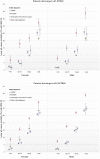Editor's Choice - Impact of initial hospital diagnosis on mortality for acute myocardial infarction: A national cohort study
- PMID: 27574333
- PMCID: PMC7614828
- DOI: 10.1177/2048872616661693
Editor's Choice - Impact of initial hospital diagnosis on mortality for acute myocardial infarction: A national cohort study
Abstract
Aims: Early and accurate diagnosis of acute myocardial infarction is central to successful treatment and improved outcomes. We aimed to investigate the impact of the initial hospital diagnosis on mortality for patients with acute myocardial infarction.
Methods and results: Cohort study using data from the Myocardial Ischaemia National Audit Project of patients discharged with a final diagnosis of ST-elevation myocardial infarction (STEMI, n=221,635) and non-STEMI (NSTEMI, n=342,777) between 1 April 2004 and 31 March 2013 in all acute hospitals ( n = 243) in England and Wales. Overall, 168,534 (29.9%) patients had an initial diagnosis which was not the same as their final diagnosis. After multivariable adjustment, for STEMI a change from an initial diagnosis of NSTEMI (time ratio 0.97, 95% confidence interval 0.92-1.01) and chest pain of uncertain cause (0.98, 0.89-1.07) was not associated with a significant reduction in time to death, whereas for other initial diagnoses the time to death was significantly reduced by 21% (0.78, 0.74-0.83). For NSTEMI, after multivariable adjustment, a change from an initial diagnosis of STEMI was associated with a reduction in time to death of 10% (time ratio 0.90, 95% confidence interval 0.83-0.97), but not for chest pain of uncertain cause (0.99, 0.96-1.02). Patients with NSTEMI who had other initial diagnoses had a significant 14% reduction in their time to death (time ratio 0.86, 95% confidence interval 0.84-0.88). STEMI and NSTEMI with other initial diagnoses had low rates of pre-hospital electrocardiograph (24.3% and 21.5%), aspirin on hospitalisation (61.6% and 48.5%), care by a cardiologist (60.0% and 51.5%), invasive coronary procedures (38.8 % and 29.2%), cardiac rehabilitation (68.9% and 62.6%) and guideline indicated medications at time of discharge from hospital. Had the 3.3% of patients with STEMI and 17.9% of NSTEMI who were admitted with other initial diagnoses received an initial diagnosis of STEMI and NSTEMI, then 33 and 218 deaths per year might have been prevented, respectively.
Conclusion: Nearly one in three patients with acute myocardial infarction had other diagnoses at first medical contact, who less frequently received guideline indicated care and had significantly higher mortality rates. There is substantial potential, greater for NSTEMI than STEMI, to improve outcomes through earlier and more accurate diagnosis of acute myocardial infarction.
Keywords: MINAP; NSTEMI; STEMI; acute myocardial infarction; mortality.
Conflict of interest statement
None reported.
Figures



Comment in
-
Acute MI is initially misdiagnosed in nearly a third of patients, study finds.BMJ. 2016 Aug 30;354:i4713. doi: 10.1136/bmj.i4713. BMJ. 2016. PMID: 27582291 No abstract available.
References
-
- Nichols MTN, Scarborough P, Rayner M. European cardiovascular disease statistics. 2012.
-
- Montalescot G, Cayla G, Collet JP, et al. Immediate vs delayed intervention for acute coronary syndromes: a randomized clinical trial. Jama. 2009 Sep 2;302(9):947–954. - PubMed
-
- Thygesen K, Alpert JS, Jaffe AS, et al. Third universal definition of myocardial infarction. European heart journal. 2012 Oct;33(20):2551–2567. - PubMed
Publication types
MeSH terms
Grants and funding
LinkOut - more resources
Full Text Sources
Other Literature Sources
Medical
Miscellaneous

